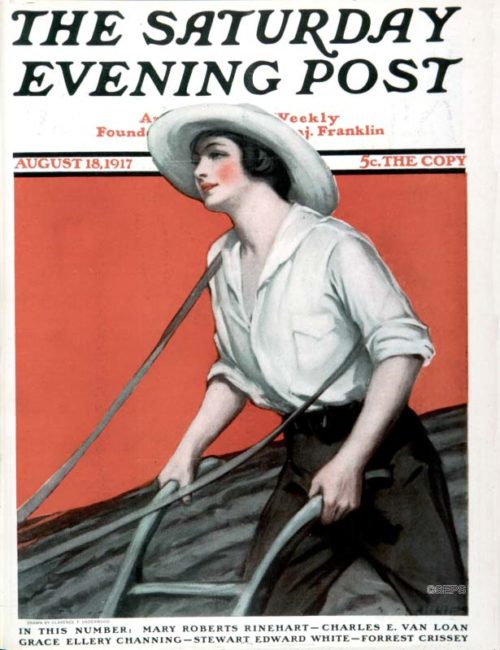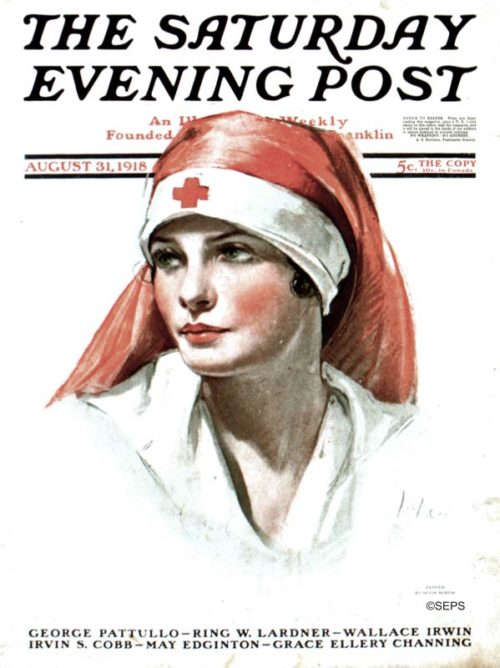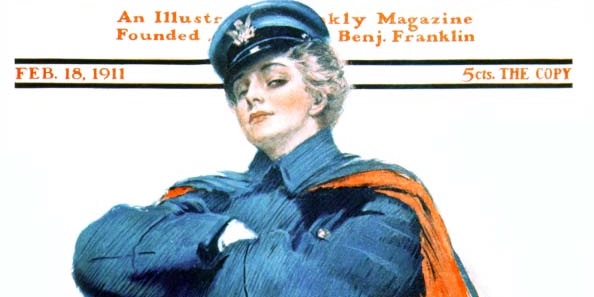These early Post covers – all published before women had the right to vote – show that they were making significant contributions to society despite their unequal treatment under the law.

Edward Penfield
September 5, 1903
This cover was an illustration to accompany a story of a woman participating in a little insider trading in order to buy an obscenely expensive car. Is there anything more modern than that? To quote the protagonist, “If I could love a man as well as I do my Manton it would be a snap.”

Philip R. Goodwin
June 9, 1906
This cover illustrated a short story called “The Noose.” The cowgirl at the center of the story, Fan Blondell, “was already aware of her power, too, and walked among the rough men of her acquaintance with the step of an Amazonian queen, unafraid, unabashed.”

Clarence F. Underwood
February 18, 1911
Most of Clarence Underwood’s female subjects were demure and daintily dressed. The woman on our 1911 cover is quite a different story: arms crossed, cap at a rakish angle, and sword by her side, she looks ready to take on just about anybody. In the early 1900s, however, there were almost no military or police roles open to women. Try as we might, we could not identify her uniform — can you?

Neysa McMein
May 26, 1917
Those on the home front were recruited to do everything they could for the war effort, including making socks, collecting scrap, starting gardens, and, as the woman on this cover is doing, making bandages to ship to the front lines.

Neysa McMein
August 11, 1917
Artist Neysa McMein was involved in the war efforts during World War I, travelling through Europe with Dorothy Parker to entertain the troops. She painted a number of wartime covers, including this pilot.

Clarence F. Underwood
August 18, 1917
With many men fighting the war overseas, the traditional work of men fell to the women. This included the decidedly unglamorous and backbreaking work of maintaining the family farm.

J.C. Leyendecker
August 17, 1918
The American Red Cross Motor Corps were a group of women who aided the U.S. military in transporting troops and supplies during World War I. These women did everything from running canteens and military hospitals to caring for patients of the 1918 flu pandemic.

Neysa McMein
August 31, 1918
The role of the American Red Cross expanded significantly during World War I. During the war, the Red Cross mobilized more than 8 million volunteers, with one-third of all Americans serving as either volunteers or donors.

Neysa McMein
March 6, 1920
Although the 19th Amendment wasn’t ratified until August 18, 1920, women had the right to vote in 15 states. The first state or territory granting women the right to vote was Wyoming, in 1890. Twelve additional states allowed women to cast a vote for president prior to the 19th amendment.
Become a Saturday Evening Post member and enjoy unlimited access. Subscribe now




Comments
The 1903 cover at the top is pretty interesting artistically. The car’s interior is very luxurious and I can believe it was obscenely expensive. As far as this woman’s insider trading goes, I’ve never heard of it in this context before, but have no doubt this particular woman pulled it off!
I can’t identify the woman’s uniform in ‘Woman in Uniform’ either. The logo in the center of the cap would be the best bet (obviously) if anyone recognizes it. It also has a cape and a sword in addition to the blue color. It could either be military or a policewoman? Maybe Angie Dickinson knows—just kidding. I’m sure she’d be as amused and confused as we are!!
The other covers of women in the air, plowing fields and doing American Red Cross work show how important they were during World War I, which is usually overlooked compared to World War II unfortunately. I’m glad the male POST publisher of 100 years ago appreciated the important contributions these women were making, and wanted their work acknowledged and depicted on the POST’s covers.